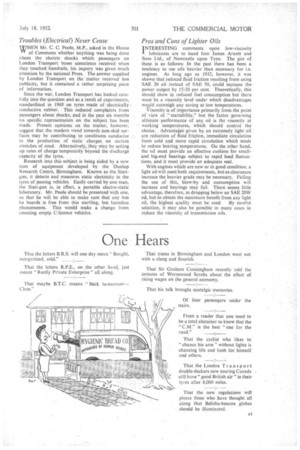Passing Comments
Page 34

Page 35

If you've noticed an error in this article please click here to report it so we can fix it.
Dogs Cause 75,0.00 Accidents a Year ROAD accidents in 1951 caused by dogs numbered 75,000 and cost the community aim. Such occurrences resulted in 3,000 human casualties, including 23 deaths. Altogether, 19,000 goods vehicles and 9,400 public service vehicles were involved in such incidents It is stated that stray unlicensed dogs, of which there, are several hundred thousand, are responsible 'for most accidents. Nearly every dog allowed' to • stray is sooner or later involved in one. The Royal 'Society for the 'Prevention of Accidents, which -recently published-an analysis of dog accidents, the Royal Society for the Prevention of Cruelty to Animals, and the Canine Defence League are taking joint steps to combat the problem, the solution of . which lies partly in impressing upon dog owners the necessity to teach their animals obedience.
A32
Brake on Travel
THE spectre of de-population continues to hover over parts of Scotland. Objectors to the application for higher fares made by David MacBrayne, Ltd., recently, raised the question, saying that higher fares in the Highlands would accelerate the trend for people: to leave these areas.
Even more fundamental was the complaint made 'at the recent conference of the District Council's Association for Scotland. The conference passed a resolution deploring the current policy, of reducing expenditure on unclassified roads. If decided to approach the Secretary of State for Scotland on the subject, declaring that these roads were as important as any others, because they were the outlet for food supplies. It was emphasized that the poor standard of unclassified roads in Scotland prevented the flow of produce from farms in remote country areas, and increased the tendency of people to. leave these areas.
Troubles (Electrical) Never Cease
WHEN Mr. C. C. Poole, M.P., asked in the House " of Commons whether anything was being done about the electric shocks which passengers on London Transport buses sometimes received when they touched handrails, his inquiry was given much attention by the national Press. The answer supplied by London Transport on the matter received less publicity, but it contained a rather surprising piece of information.
Since the war, London Transport has looked carefully into the question and as a result of experiments, standardized in 1948 on tyres made of electrically conductive rubber. This reduced complaints from passengers about shocks, and in the past six months no specific representation on the subject has been made. Present opinions on the 'matter, however; suggest that the modern trend towards non-skid surfaces may be contributing tO conditions conducive to the production of static charges on certain stretches of road. Alternatively, they may be setting up rates of charge temporarily beyond the discharge capacity of the tyres. Research into this subject is being aided by a new item of equipment developed by the Dunlop Research Centre, Birmingham. Known as the Statigun, it detects and measures static electricity in the tyres of passing vehicles. Easily carried by one man, the Stati-gun is, in effect, a portable electro-static laboratory. Mr. Poole should be presented with one, so that he will be able to make sure that any bus he boards is free from this startling, but harmless phenomenon. This would make a change from counting empt4/ C-licence vehicles.
Pros and Cons of Lighter Oils
I NTERESTING comments upon low-viscosity lubricants are to hand fom James Arnott and Sons Ltd., of Newcastle upon Tyne. The gist of these is as follows: In the past there has been a tendency to use oils heavier than necessary for i.e. engines. As long ago as 1932, however, it was shown that reduced fluid friction resulting from using SAE 20 oil instead of SAE 50, could increase the power output by 15-20 per cent. Theoretically, this should show in reduced fuel consumption but there must be a viscosity level under which disadvantages wstild outweigh any saving at low temperatures.
Viscosity is of importance primarily from the point of view of " startability," but the factor governing ultimate performance of any, oil is the viscosity at working temperatures, which should control the choice. Advantages given by. an extremely light oil are reduction of fluid friction, immediate circulation from• cold and more rapid circulation which tends to reduce bearing. temperatures. On the other hand, the oil must provide an effective cushion for smalland big-end bearings subject to rapid load fluctuations, and it must provide an adequate seal.
With engines which are new or in good condition, a light oil will meet both requirements, but as clearances increase the heavier grade may be necessary. Failing the use of this, blow-by and consumption will increase and bearings may fail. There seems little advantage, therefore, in dropping below an SAE 20W oil, but to obtain the maximum benefit from any light oil, the highest quality must be used. By careful selection, it may also be possible in many cases to reduce the viscosity of transmission oils.




























































































